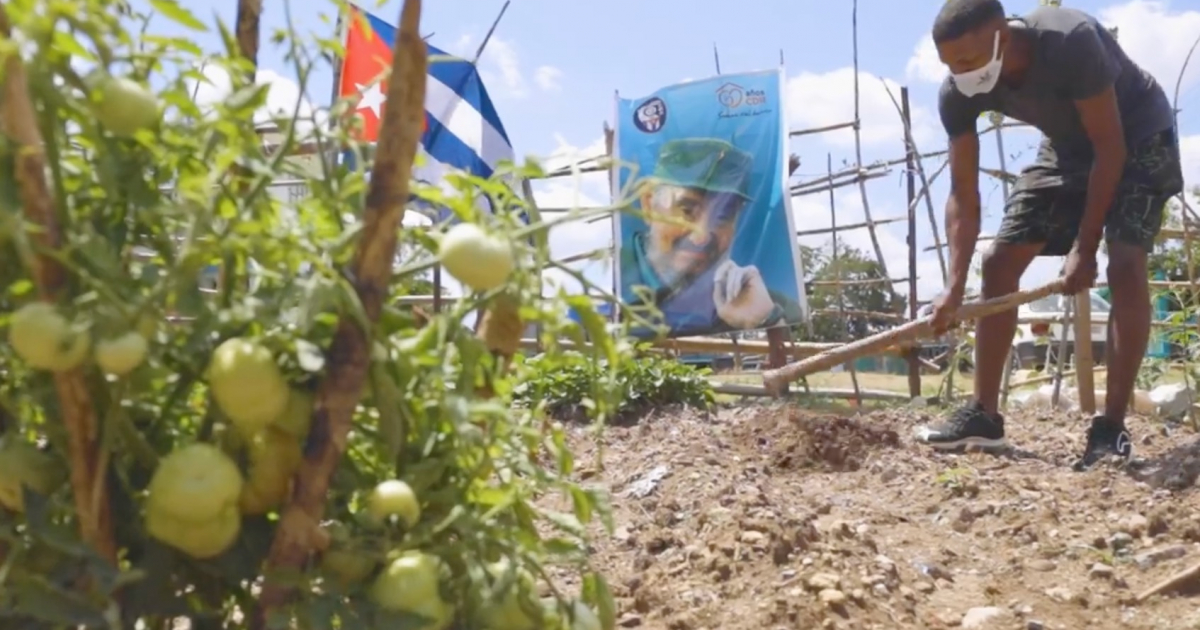
Lucía Betancourt Álvarez is president of a CDR in Cuba and has set up, together with her 24-year-old son, a garden in Los Pinos, a town in the Arroyo Naranjo municipality, in Havana. There they have planted corn, beans, tomatoes and chili. Both say they donate part of their crops to the community. This would not have much relevance if it were not for the fact that one of the five former spies, Gerardo Hernández, has congratulated the family for joining the self-sufficiency project "Cultiva tu pedacito." And mother and son have agreed to record a video in which the young man can be seen holding a hoe in his hand, swinging, with a photo of Fidel Castro, smiling behind him and a Cuban flag waving in the same plane.
In the propaganda audiovisual, both are heard saying in unison: "Cultivate your little piece," to close with a flourish a performance that the former spy Hernández celebrated on the social network X (formerly Twitter) with a euphoric: "Yes can".
It is not the first time that the national coordinator of the Committees for the Defense of the Revolution (CDR) makes an exalted comment, inspired by self-consumption initiatives, such asthat of Juana Aleida, an old woman who planted garlic, spices and taro in pots, on the balcony of his apartment, located on the fourth floor, in La Lisa (Marianao), also in Havana. This fact would not be news in any other country in the world, but the Island's propaganda system served as a hook to promote the "Grow your piece" campaign, which aims to promote survival planting (they call it promoting food sovereignty) in an Island plagued by shortages and shortages of basic products.
And, of course, the former spy, turned politician, took the required photo in Juana Aleida's little piece and, as expected, the image did not go unnoticed. He immediately sent up to 1,500 comments from Cubans who reminded the head of the Communist Party's control machinery in the neighborhoods of the vulnerable situation in which the regime keeps, above all, the elderly. Far from reconsidering, Hernández attacked those who criticize him for using other people's misery to engage in politics. He did not speak of survival in the cultivated bits but of "being creative to resist."
Those who suffer from shortages in Cuba have opted to take advantage of any little piece of land to take advantage of it. This is the case of residents of Vedado, who have planted banana trees on the central 21st Street.There are more unusual examples, such as that of residents in Cerro, who also planted bananas in a historic pothole in their neighborhood.
Something similar happened on Mujica Street, between Río and Cuba, in Matanzas, where the neighbors plantedbanana, corn, taro and pumpkin on a road that had been closed to traffic for years. After the news went viral, the Government took action on the matter and repaired the road.
But the ingenuity of Cubans reached historic highs when it was learned that workers at the Rancho El Tesoro hotel, on La Isla de la Juventud, They were raising clarias in an old disused cistern at the two-star facility, belonging to the Gran Caribe chain.
It's not just about growing your little piece on land, but also about getting food out of fresh water. In fact, 400 clarias weighing 400 grams were planted at the Isla de la Juventud hotel, the evolution of which is unknown and whether, as planned, they were served to visitors.
Given the food shortage in Cuba, the Government extendedUntil next March 31, the non-commercial import, free of tariffs, of food, medicines and toiletries, without limits on their value. This allows families residing in countries such as Spain or Cuba to send supplies to their remaining relatives on the Island and who see the prices of basic necessities skyrocket.
What do you think?
SEE COMMENTS (1)Filed in: